
Make Your Marketing Pop
The secret recipe for corporate Kool-Aid, a healthy mix of Mission, Vision, and Values — or “MVV.” These simple statements help every business establish who they are, what they do, and how they do it. But, while your MVV is a critical step to developing your business plan and creating a pathway to growth, they won’t capture the hearts and minds of customers. For that, you need to shift your focus from you to them.
Much like your business plan, your marketing plan can be built around three core principles — Purpose, Opportunity, and Personality. Together, these things can help your marketing “POP.” (And who doesn’t love a good acronym?)
At face value, it may seem that MVV and POP overlap and they do. But as we dive deeper into each, you’ll see how reframing to focus on the consumer can create a roadmap to inspire more meaningful relationships.
Perhaps the most popular, and misunderstood, buzzword in marketing today is Purpose. With study after study showing that customers are more likely to buy from companies with a clearly defined Purpose, boardrooms across the globe are rushing to find a cause or social movement to build their brand around. But working to ensure social good is not the only definition of Purpose, and, for many brands, trying to force yourself into a conversation where you don’t belong can do more harm than good.
So how do we define Purpose?
In its simplest form, Purpose is your promise to your customers. For a fortunate few, that may mean championing a cause — as the corporate white knight here to save us all. But, more often than not, it’s about providing a product or service that adds value to your customers’ lives and doing so in a mindful way.
To find your Purpose, start by looking at your Mission and Vision statements. Your business was created to solve a specific problem or market challenge. Think about what you are solving for now and how it will make your customers’ lives better in the future. Be honest. Are you really changing the world or just the lives of your customers? Either is fine, as long as your products and services align with what you are saying. Authenticity is key.
Next, look at your Values statement. This is your business’s moral code. If Mission and Vision explain what you do, Values help define how you do it. Use your Values to define a responsible path to identify the impact your business will have on your employees, partners, customers, and community.
Once you understand why you exist, what customer challenge you’re trying to solve, and how it will positively impact those around you, you’ve got your Purpose.
If your core Purpose isn’t a big social cause, don’t worry. Customers don’t need you to be focused on changing the world at every turn. They just want to make sure you are using your power for good. So, take up a cause that you believe in, give back to charities and organizations you feel are making a difference, show your customers you care by making these initiatives a part of your culture and your story. Just don’t try to build your brand around it.

When we talk about Opportunity, we’re talking about two familiar questions:
- How can we share your Purpose with your audience in a unique way?
- How, and where, do your customers want to engage with your brand?
This is why advertising was created: to help brands turn their reason for being into consumers’ reason for caring. This was something that was much simpler before your audience’s attention was split across hundreds of screens, points of purchase, and social networks. Now, in order to identify the right opportunities, you not only have to weigh what messaging resonates with your audience in each channel, but you also have to understand how your audience uses each channel to engage with your brand.
The first step in identifying the right Opportunity is letting go of the traditional purchase funnel. Let your audience dictate where and how they want to engage with you, then build tactics around their path to purchase. This may mean rethinking how you utilize traditional media and forgetting how you define above-the-line and below-the-line advertising. But, by letting your consumer define the right communication flow, you can seamlessly integrate into their story to drive the right action at the right time.
Once you’ve identified the tactical opportunities, look at your messaging and focus in on the unique motivators for your audience across those tactics. The best way to figure out what truly motivates your audience is by listening. See what customers have to say about your brand in their social feeds, read reviews, and watch reaction videos — let your audience tell you what they love about your brand and where you’re missing the mark. Then run the same exercise for your competition. By doing this, you’ll be able to identify creative territories that your brand can own.

One of the most important elements for every brand is consistency. You want to ensure that your customers are engaging with the same brand at every touch. Not just stylistically but tonally. Your brand needs a Personality.
So, ask yourself: If you met your brand at a party, who would they be?
This question can help reveal the specific traits that make your brand — you. Furthermore, they can help define the tone and style for your marketing, helping you stand out with customers in a unique and powerful way. Most importantly, these traits provide a playbook that ensures every touch presents a consistent, familiar face in the market.
The key to defining your Personality is to think about who your customers want to engage with and who they’ll trust to provide a particular product or service.
On the next couple of pages, we’ve included some examples of POP that Crow Creative has created with our clients, to help demonstrate how this new approach adds value every day.
AUL founded the used-car service contract industry with the introduction of the first-of-its-kind Any Year, Any Mileage® vehicle service contract. However, as their products and services evolved to include a full range of Finance and Insurance (F&I) products, they were still seen only as a service contract provider.
In 2017 they hired Crow to help them refresh their brand and raise awareness for their full product offering.
Together, we crafted their Purpose, Opportunity, and Personality, and used that to guide us in the creation of a cross-media campaign that helped AUL become the #1 followed F&I Provider on Facebook and drove over 1 million new contracts and business opportunities.
Purpose
To provide dealers and agents with a complete range of F&I services to grow their business while providing their customers with added peace of mind in every mile.
Opportunity
Become a sales enabler. Transition from pushing products and services to sharing educational content that can help agents and dealers understand the market, their customer and our expanded products set. Convert our social channels into a go-to resource for information and tools.
Personality
The knowing sage. Approachable, knowledgeable, and helpful. We’re in this together.
The Work
Print:

Social:
Content/Sales Enablement:

In 2015, United Water, a regional water utility based in the northeastern United States, was acquired by SUEZ, a French water and waste management company. With this acquisition, SUEZ hoped to roll out their existing brand and messaging; however, the global brand message — leading a resource revolution — didn’t connect with the U.S. consumer.
While European countries were more painfully aware of water scarcity and diminishing natural resources, the U.S. market was more passively engaged. They saw the risks on the horizon but did not feel the same immediacy as Europe. SUEZ turned to Crow to help them refine their brand for this new consumer mindset.
Together we developed their Purpose, Opportunity, and Personality, helping them become a premier utility in the region and increasing their consumer satisfaction scores across the board.
Purpose
To lead the charge for a resource revolution. Ensure that the U.S. is ready for what’s to come.
Opportunity
Humanize the resource revolution and demonstrate how, by acting now, we can help minimize the impact later. Utilize social to educate and engage customers and reposition our collateral to demonstrate a clear problem solution.
Personality
The inspiring leader. Active, engaging, and personable. We help you understand the issues and identify the right solutions.
The Work

Collateral:

Experiential:


As with MVV, defining your POP is an ever-evolving process. But by establishing your Purpose, Opportunity, and Personality, you can create a simple roadmap that ensures your internal stakeholders and agency partners are aligned in understanding your vision for the brand. This can help improve onboarding, aligning internal and external partners and stakeholders, and ultimately increase the effectiveness of your brand for years to come.
For more information on POP, or to work with our team to establish your brand’s POP, contact us at Hello@CrowCreativeAgency.com.






